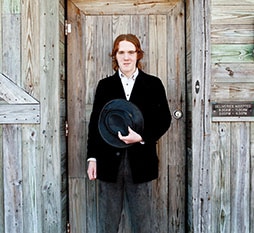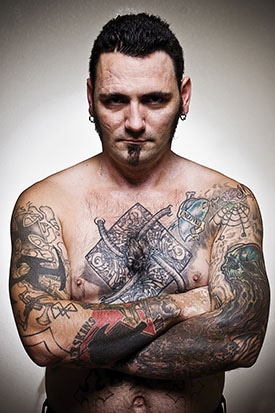Why They Join
Sociologist Pete Simi, who has conducted 17 years of fieldwork with radical-right extremists, discusses why people join hate groups and how they come to leave.
A SCHOLAR WHO’S DONE EXTENSIVE FIELDWORK ON THE RADICAL RIGHT DISCUSSES WHY PEOPLE JOIN EXTREMIST GROUPS, AND HOW THEY LEAVE
Earlier, in 2010, Simi and Robert Futrell of the University of Nevada-Las Vegas wrote the award-winning American Swastika: Inside the White Power Movement’s Hidden Spaces of Hate, a book that relied on in-depth interviews and observation of hate group members. Simi is currently studying risk factors for radicalization among domestic terrorists as an investigator for the National Consortium for the Study of Terrorism and Responses to Terrorism at the University of Maryland and is also working on a project funded by the Harry Frank Guggenheim Foundation to understand how extremists defect from the movement.
You’ve spent a great deal of time interviewing current and former adherents of the radical right about their reasons for joining the movement. Are there common themes in their personal histories? Do they tend to have similar personalities, or experiences, or come from similar socioeconomic backgrounds?
It’s pretty diverse but if I had to nail it down I would say one of the most common background characteristics is some kind of family disruption, whether that be divorce or parental abandonment, a parent becoming incarcerated, or substance abuse by one or both of the parents. That kind of thing is very common, but I should emphasize that I have interviewed folks who report coming from very “normal,” typical, stable upbringings as well.
In terms of socioeconomic backgrounds, there’s a common misconception that only people from lower economic backgrounds are attracted to these types of groups. I can say not only from my own research but also that of others like [scholars] Kathleen Blee and James Aho that this is just not the case — people from a wide cross section of socioeconomic backgrounds become involved. I think this is really important not only in terms of challenging a pretty pervasive stereotype but also recognizing that these types of groups have a much wider recruitment potential than is often recognized.
In terms of personality, I wouldn’t say there is one type of personality, but I would say there are certain characteristics of thinking that make a person more prone or susceptible. For instance, low tolerance for ambiguity seems to cut across most if not all extremist ideologies; this goes along with a certain type of concrete thinking where a person wants to categorize things as “black and white” rather than deal with so-called “gray areas.”
At the most fundamental level that’s what most of these movements are all really based on — oversimplifying a highly complicated world — and that’s a powerful thing to offer people, especially those who feel lost or are looking for some easy answers. Now, obviously, a lot of people who have a low tolerance for ambiguity are not involved in extremist groups, so it’s certainly not a perfect relationship.
But in general, there’s really no single profile. And, of course, there are doctors, lawyers, scientists and other highly educated folks who are involved in these groups. So again, I think this underscores my previous point that you do see a wide range of individuals involved in these groups and it’s really important that we challenge some of these common misconceptions.
What causes these people to finally embrace violence? And do all of them, at least theoretically?
Well, some people were already violent before they ever became involved in extremism. Some were exposed to violence in the home as children or were already getting in fights at school or in their neighborhood.

But in terms of your question, no, not all members are violent. There are folks who are extremists but don’t engage in any violence, at least not directly. Some of these folks talk about violence being counterproductive to the “cause,” or, as they get older, may feel that violence is a younger person’s game, so to speak.
Fortunately — and this is true for all extremists — there is far more violent talk than there is violent crime. In American Swastika, we discussed this paradoxical relationship between extremists coming together in “hidden spaces” and immersing themselves in violent talk. On the one hand, the violent talk with other like-minded extremists is a “training ground” that can accelerate an individual’s propensity to violence by building ties to other members of the group and giving the person a sense of group identification — the violence is on behalf of the collective; it’s for the group. The ideology tells the person that any violence is a form of self-defense necessary to save the white race from extinction and this gives each person license and rallies them together in their cause to save the white race.
But in other cases, individuals may find the talk exhilarating but ultimately become frustrated with the fact that there’s more talk than action. So they branch off by themselves or with a smaller number of other folks who feel the same and use violence to bring talk to fruition. Still others may find that getting together with other extremists and talking violently is cathartic — the spaces and talk becomes a safety release valve where individuals can blow off steam and continue living dual lives as extremists in hidden spaces but “normal” people at school or work. You can imagine that without the hidden spaces a person living this kind of dual life might feel isolated and find it difficult to remain committed to the “cause.”
The point is that from a threat assessment perspective, it’s very difficult, if not impossible, to know how different individuals are going to respond to these spaces and the different kinds of violent talk that is so pervasive in them. As we discuss and debate different responses in terms of policy or investigation strategies or what have you, I think we need to be very careful about adopting either more overt or insidious approaches that rely on criminalizing association and speech.
After Wade Page’s shooting rampage, I was asked by a producer from a major cable news network, “Why wasn’t he arrested, since it was known he was in a neo-Nazi music band?” As you can imagine, I was a bit taken aback by this question. Of course, I explained that being in a neo-Nazi music band wasn’t against the law, nor were the neo-Nazi tattoos Page had inscribed on his body, nor were his neo-Nazi beliefs. But faced with the specter of mass violence and terrorism, it can be difficult to remember that, so I think it’s critical we keep the Constitution at the forefront of our discussions when we focus on how to respond to this type of violence.
Kathleen Blee interviewed many women on the radical right and found that most did not initially join the movement for ideological reasons. Have you found the same?
Yes, I’ve found pretty similar things for both males and females. Ideology is important but it’s not necessarily the initial attraction that draws the person to the group. The ideology is often there early on but it’s not very crystallized — it’s like there may be bits and pieces of the ideology that are attractive early, but rarely do you have someone who has a full appreciation for the ideology and then seeks out the group. Over time, ideology becomes more important as the person becomes more familiar with the ideas. But it’s not necessarily a smooth process where each member becomes a full convert to the same extent. I’ve interviewed individuals who when they were fully immersed in the movement claim that they didn’t believe in certain aspects of the ideology. Some of these folks talk about how much they had bought into hating black people but never really understood or identified with the anti-Semitism, so they would just go along with that part.
And this is true in terms of violence as well. In some cases, the violence is more about personal turmoil and unresolved trauma. As scholars like Clark McCauley and others have pointed out, we need to be careful to distinguish between radical attitudes or beliefs and radical action like violence. Too often, we assume that radical action like violence is simply a product of radical beliefs. But it’s typically far more complicated than that.

We often want to fit violence into one of two categories, ideological or non-ideological. But in reality, violence can be and probably often is spurred by both ideological and non-ideological motives. I think the Oak Creek, Wis., shooting rampage is a good example of this — Wade Page was likely responding to a series of personal troubles such as depression regarding a failed romantic relationship and financial difficulties, but also was selecting a target that from his perspective represented “non-white” or “racial enemies.”
People on the radical right generally subscribe to a variety of baseless conspiracy theories, not least of which is the idea that Jews run the world. Why are these people so vulnerable to such ideas? Is it just a lack of critical thinking skills, or is there something else at work here?
Sure, a lack of critical thinking is part of it. Conspiracy theories can also be attractive because they give people the sense that they have special insight shrouded in mystery and excitement.
But we need to be mindful that conspiracy theories have a long history with a broad spectrum of influence. Conspiracy theories are certainly not the sole province of a few “wild-eyed wackos.” The conspiracy theory that “the Jews” control world affairs is a perfect example. Unfortunately, various iterations of that idea have existed for a long, long time and have influenced everything from individual-level violent anti-Semitic attacks to government-organized genocide.
You’ve also talked to former members of extremist groups about their reasons for leaving. Generally, what happens to people to cause them to decide to quit? What kinds of things have you learned about the process of leaving? What causes them to begin their transformation? Do most eventually leave?
Well, just like people join for lots of different reasons they also leave for lots of different reasons. Ironically, that same familiarity with the ideology that may lead some to become more committed over time is part of why other folks ultimately leave. As they become more familiar with the ideas, they realize this is really pretty warped stuff and, more than anything, the ideas and lifestyle become too constraining. I’ve had folks tell me they left in part because they “got tired of wearing the uniform,” both figuratively and literally; some folks make comparisons to cults and say the level of control is overwhelming after a while. Formers have told me that they just got tired of not being able to listen to certain music or eat certain foods or wear certain clothes or hang out with certain people. Many said they had just finally had enough.
For some, it’s a sense of moral uneasiness that begins to emerge with the ideology and especially the violence, and this uneasiness starts to nag at the person, creating distance between them and the group. Others begin to envision where they’ll be if they continue — “prison or the grave” — and start to realize this isn’t the life they want for themselves or their family.
But I think the most common factor involves a growing realization that, as much as the movement professes loyalty and kinship and all of these affirmative qualities, there’s really a tremendous amount of backstabbing and infighting that occurs. As people experience and observe this, they begin to see the movement for what it is and start considering moving on.
But leaving can be very difficult. There are these feelings of betraying your comrades, in some cases your relatives, and trying to alter your frame of mind. One former who was really only involved for a few years told me that after he left and was attending college, when he encountered people of other races/ethnicities “it would get my hackles up.” He talked about this sense of having to feel on guard but also related that he would immediately start talking to himself, saying there was no reason to feel that way. So it’s definitely a process for folks to leave. You don’t just decide one day “it’s over” and that’s that. Yes, some people walk away much more quickly and with far less difficulty than others, but typically it’s quite a process.
One of the common misconceptions that I see a lot is the idea that “once a hater always a hater” or “once a gang member always a gang member” — or fill in whatever population you want that has been labeled as deviant and therefore beyond redemption. This is folklore; it’s simply not true.
People do leave these groups and some really change their lives in substantial ways. I’ll never forget what one of the first formers I interviewed told me: “When people who know me today find out I used to be a neo-Nazi, they can’t believe it; and when people I used to be associated with as a neo-Nazi find out who I am today, they can’t believe it either.” This person’s comment really underscores a pretty common theme among formers — they have almost lived two different lives because who they are today is so different from who they were as an extremist.
What can be done to help people getting out these groups? Is there a role for government? Civil rights organizations? Other kinds of institutions or groups?

I hate to sound clichéd, but we all play a role in creating extremism, so it seems to me we all need to find ways of diminishing extremism. Certainly, part of that involves helping individuals move away from this type of life. I think all of those that you mention have a role to play. All of these sectors have different resources, expertise and so forth, and in some combined fashion are most likely to have the greatest impact.
I think one thing we need to do is look around and see what’s being done and what’s working. Now, compared to Europe, the U.S. doesn’t really have much in terms of programs designed specifically to help members of white supremacist or similar groups. But one group, a private, nonprofit organization fairly recently founded is Life After Hate (LAH). The organization was started by former hate group members who have been doing a lot of outreach in terms of providing testimonials and trainings to schools and law enforcement and other community groups across the country. The focus of their message is the importance of using compassion to inform prevention and intervention efforts and aftercare for individuals who want to change their lives but may need various types of support. I think LAH is a very promising development and I hope it will continue to find the resources that it needs to expand the services it provides.
But one of the first things we have to decide is whether an extremist or gang member is worth the resources. I’ve heard it said too often: “Why should we help these people? They don’t deserve our time or resources.” When we make those kinds of decisions, we increase the likelihood that people won’t be able to move away from these groups. A lot of the formers I’ve talked with discuss the difficulty of wanting to leave but not being sure how accepting people will be. They’re in this no-man’s-land, which is pretty common for formers of all types.
Part of the problem is that formers may also be verbally or physically confronted by violent anti-racists who may think this person is fair game. So I think we have to ask ourselves whether what we’re doing is making it harder for people to leave these groups and, if so, I think we should revise our approach.


